Menu
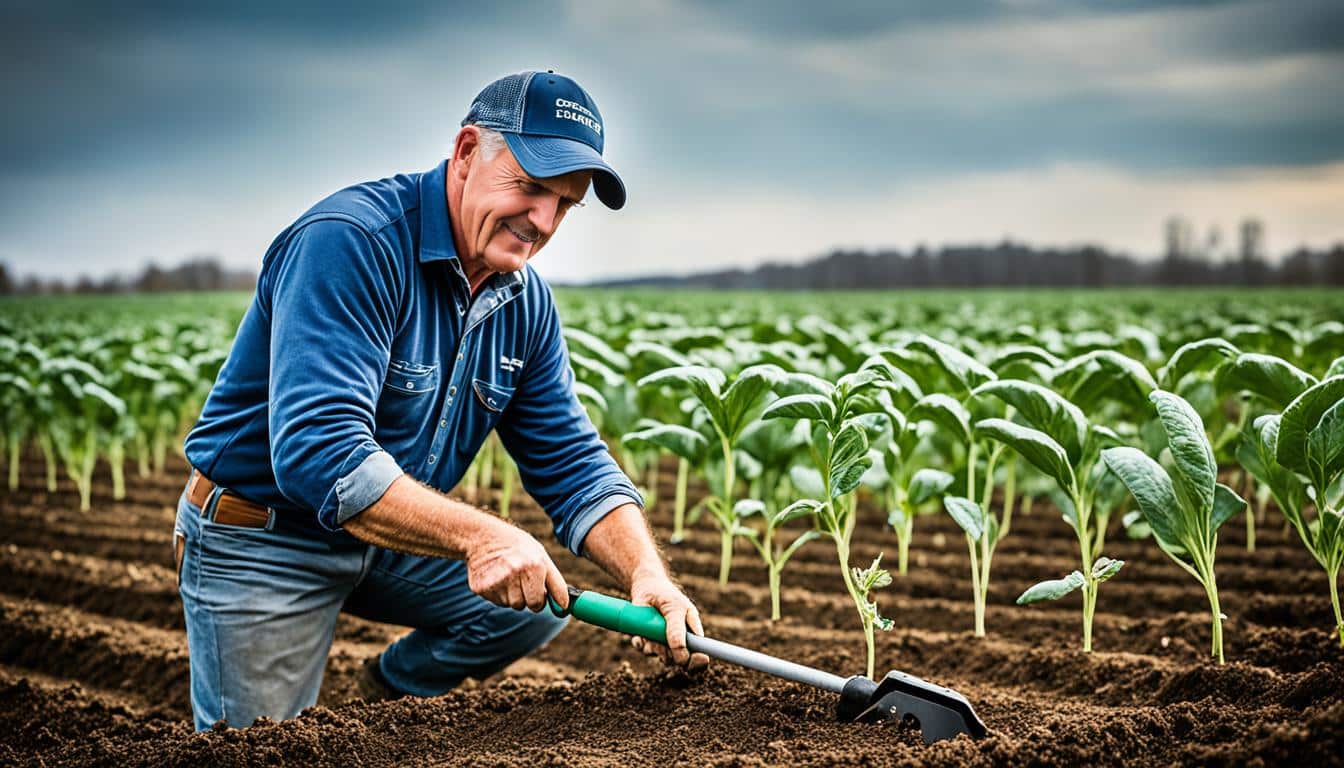
Did you know that better workplace design and ergonomics can prevent 30% of back injuries? This can avoid surgeries that may not be needed. A 2016 study by the US Department of Labor shows that acting early to solve ergonomic issues helps a lot. This is especially true in farming.
Farmers often suffer from back pain, knee, and shoulder problems. The need for better ergonomic solutions is clear. Problems like heavy lifting and working in harsh weather impact older farmers the most.
A case study from a die-cast manufacturing plant highlights this well. Over ten years, they made a lot of money through ergonomic changes. They spent $495,500 and gained $1,910,000 every year after that. Their workers’ compensation costs dropped by 93%. There was a 67% cut in absenteeism and productivity went up by 54%. This shows investing in ergonomics is smart, not just a cost.
The farming sector can gain a lot by making similar ergonomic improvements. By focusing on better tools and ways of working, agriculture can fight common health issues. This will not only help the workers but also boost efficiency. Now, we’ll look at some detailed case studies and research. These will show how important and beneficial these efforts can be.
Farming often involves risky work that can harm the body. These dangers lead to many farmers facing muscle and bone issues. The response to these problems is to improve how farming tasks are done. This includes making better tools and changing how farms are laid out. These changes aim to keep farmers healthy while making sure work is done well.
By using good ergonomic practices, we can cut down on injuries. A study in 2016 showed that 30% of back injuries, which sometimes need surgery, can be stopped. This is through better ways to plan work and use tools.
Recent studies prove the big impact of these efforts. For instance, by spending $495,500 on better work environments in a metal factory, they saved $1,910,000 every year for ten years.
After implementing a full ergonomics program, a manufacturing plant witnessed a 93% drop in workers’ compensation costs, a 67% reduction in absenteeism, and a 54% increase in productivity.
| Company | Improvement | Outcome |
|---|---|---|
| Deere and Company | Ergonomic Training Program | 83% reduction in back injuries, 32% decrease in healthcare costs |
| Medical Call Center | Ergonomic Adjustments | Injury rate reduced by 15%, complaints dropped to zero |
These cases make it clear that being ergonomic is good for business and health. They show how better day-to-day work leads to a safer, more productive farm. In the bigger picture, using ergonomic ideas helps both the farm and the farmer stay healthy.
Farm work is tough and can lead to health issues. One big problem is musculoskeletal disorders (MSDs), especially low back pain. This makes it crucial for farms to adopt better ergonomic solutions.
Farm work is the second-highest cause of injuries and health problems at work. So, making these changes is very important given these facts.
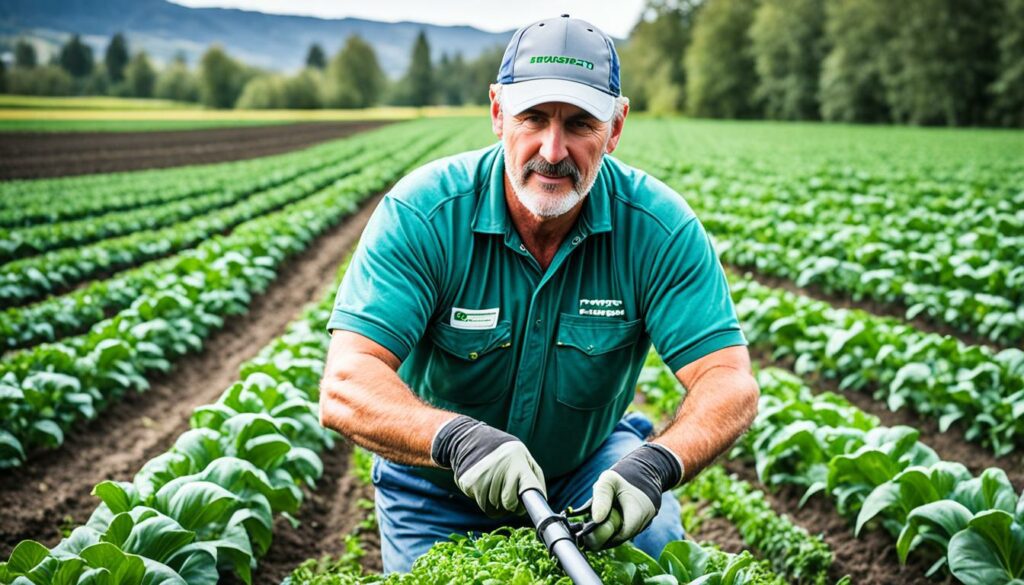
Musculoskeletal disorders are common among farm workers. They can lower productivity and quality of life. Low back pain is the main issue, caused by tasks like lifting and being in bad positions.
These tasks can also lead to knee and hip problems. This happens when tasks like bending or kneeling are done over and over.
Farming tasks that are hard on the body include bending, stooping, twisting, and lifting heavy things. Making the tasks easier can help. For example, using smaller tubs for picking, long-handled tools, or machines for cutting can reduce the risk.
Taking breaks during work can also help by giving the body a rest. This lets workers feel less pain and keep working.
| Activity | Risk Factor | Ergonomic Solution |
|---|---|---|
| Harvesting Grapes | Repetitive lifting, awkward posture | Smaller tubs, long-handled hoes |
| Vineyard Work | Upper extremity and trunk forces | Pneumatically-powered cutters |
| Plant Lifting | Heavy loads | Extended-handle carriers |
Many farm workers are over 40, which puts them at more risk from the work. A study looked at what tweaks could be made to help. This study checked the work environment and the workers’ health to find the best solutions.
Ergonomic changes in farming are better when everyone is involved. Farmers know best about their daily work and struggles. So, working together with them is key to finding solutions they will actually use. This makes the changes more likely to stick.
Evidence-based ergonomics in farming show that the work farmers do is so important. Their insights can make ergonomic changes work better. Also, working together lowers costs from sick days or injuries.
When farmers and experts work together, they make great changes. The farmers know what’s practical, and the experts know the science. This mix leads to changes that fit the farm perfectly, making work easier and more satisfying. Research shows this approach improves safety, cuts risks, and brings in new ideas, making ergonomic changes last.
Case studies in farming show how better workplace design reduces injuries. They reveal that good ergonomics can stop 30% of back injuries. This means fewer people need surgery, as seen in a 2016 report by the US Department of Labor.
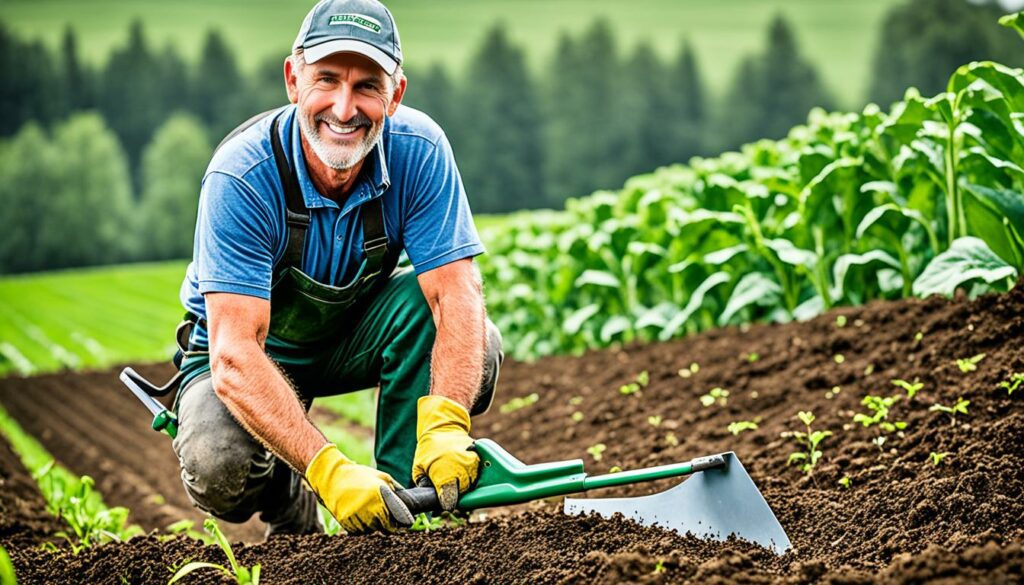
A training programme by Deere and Company cut back injuries by 83% in ten years. This also lowered healthcare costs by 32%. These results show that focusing on how people work can bring big benefits.
At a die-cast factory, they saw a huge improvement after making ergonomic changes. Costs for worker’s injuries fell by 93%. They also had less time off, and their work was more efficient.
Safety in Motion worked to cut down how much workers had to push and pull from 1998 to 2007. This made injuries fewer and work easier. Their approach shows the real value of involving everyone in finding solutions.
Looking at the money side, ergonomic changes are a smart investment. For example, a die-cast plant spent nearly half a million dollars. In ten years, they saved more than $1.9 million because of this. This shows how investing in ergonomics can make real financial sense.
“Ergonomics is not just about preventing injuries; it’s about fostering a work environment where safety and productivity thrive.”
These examples highlight the remarkable benefits of careful ergonomic planning. Matching ergonomic improvements to farming work means better health and productivity. It sets a strong base for the future of work safety.
| Case Study | Ergonomic Improvements | Results |
|---|---|---|
| Deere and Company | Ergonomics training programme | 83% reduction in back injuries over ten years |
| Die-cast Manufacturing Plant | Comprehensive ergonomic solutions | 93% drop in workers’ compensation costs, 67% decrease in absenteeism, 54% rise in productivity |
| Safety in Motion | Reduced manual pushing/pulling in vending carts | Reduced injuries and increased labor efficiency |
| Die-cast Plant | Investment in ergonomic solutions | $495,500 investment yielding $1,910,000 annual benefits |
| Merchandise Tote Box Management | Reduced weight and frequency of heavy tote boxes | Significant reduction in strains and sprains |
Advanced harvesting methods are making a big difference in farming. They focus on making work easier for farmers without lowering how much they can harvest. Let’s look at examples in coffee and orange picking.
The use of ergonomic bags for coffee picking is a great success story. Previously, picking coffee led to a lot of back and shoulder pain. But now, with bags that spread the weight better, workers feel less physical stress.
They also had training on how to use the bags properly. Plus, regular meetings helped spot and fix any issues fast. This teamwork between workers and designers is key to making these solutions last.
In areas with slopes, picking oranges was hard before special tools were used. These tools are designed to help with balance and make picking easier. They’re the result of close work between farmers and experts in ergonomics.
These better ways of picking not only prevent injuries but also encourages more ideas and improvements. They show how with the right approach, farming can become safer and more efficient.
“The results demonstrate that ergonomic design best practices can dramatically improve both worker wellbeing and operational efficiency, marking significant progress in agricultural ergonomics.”
The changes in coffee and orange picking show how much better farming can get with the right tools. They’re improving life for workers, paving the way for better farming in the future.
Using new designs to make tools better for us is key in reducing injuries at work and making jobs easier and safer. These changes in tools affect farming and lead the way in good design around the globe.
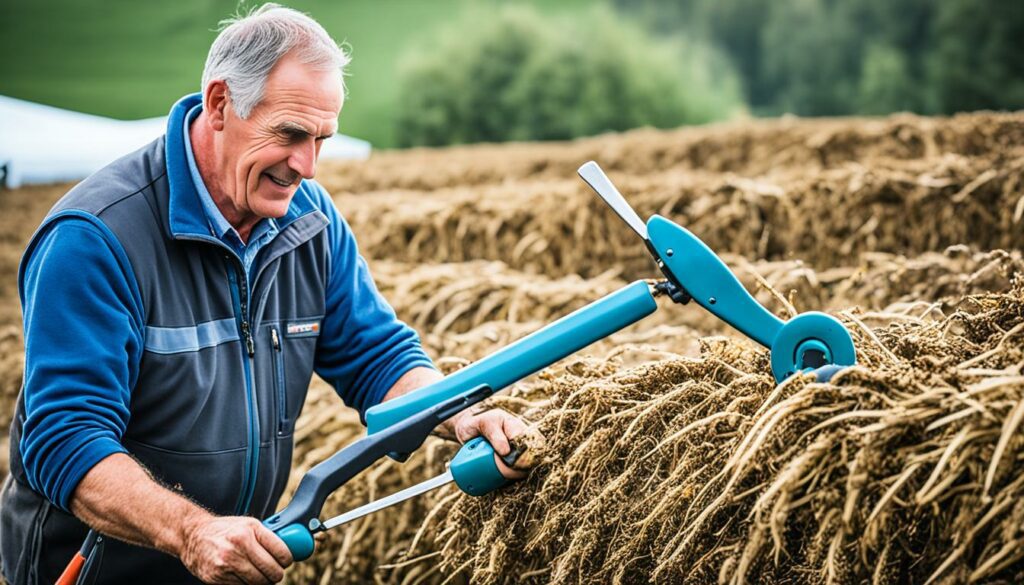
The ergo bucket carriers are a big step forward in making work tools better. They spread the weight so it’s not all on the back and shoulders, cutting down on pain and tiredness. With these carriers, less farmers hurt their backs, improving work life.
Special gloves are a game changer in farming. They’re made to be grippy, stretchy, and tough to stop hands getting tired and sore. These gloves fit the tough, repetitive jobs on the farm perfectly. Using such gloves makes farmers happier and more productive, and stay injury-free.
These examples show how smart changes in tools can really make a difference. By focusing on good design, tools in farming have become easier and safer to use, helping everyone.
Many farmers face musculoskeletal disorders (MSDs), with Korea noting 84.6% of farmer diseases were MSDs in 2020. Back pain affected 47.3%, knee disorders 27.3%, and shoulder issues 6.9%. There’s a big need for ergonomic solutions to help them.
Making farming tasks easier on the body is crucial. Many farmers bend a lot or do repetitive motions, leading to problems. Redesigning tools and jobs can make them work more comfortably.
For example, improving how we pick coffee or oranges means less strain. It could be a new design for a tool or a smarter way to do the job.
To make things better, we need a clear plan. First, we check the work for risks. Then, we fix these problems and see if our changes are working.
In Korea, making peach farming easier got a thumbs up. Workers rated improvements highly. Most were over 40, highlighting the need for changes that keep older farmers safe.
Using RULA, we measured how different practices affect the body. After adjusting, there were fewer injuries. This shows, with smart planning, we can really help farmers stay healthy and productive.
| Risk Factor | Prevalence |
|---|---|
| Stooping or Prolonged Trunk Flexion | 51.9% |
| Repetitive Movement | 29.6% |
Recent studies in ergonomics have shown great potential in making farming workplaces better. They help with creating and using practices that make work safer and more productive. It’s all about cutting down on injuries while doing more.
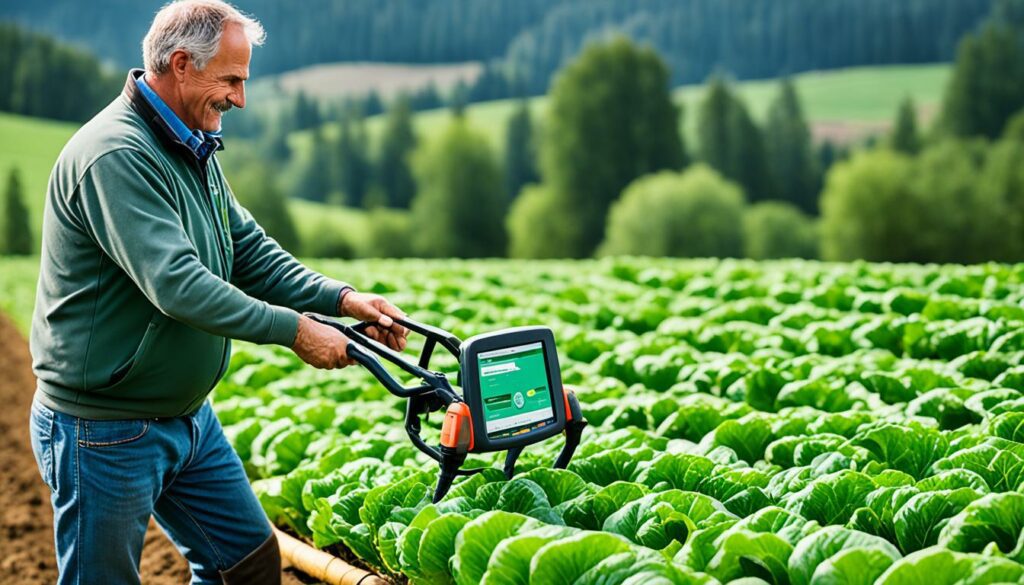
I’ve seen how changing the workplace can stop many back issues. In fact, it might prevent about 30% of cases that would have needed surgery. This shows how important it is to use what we learn to keep everyone safer at work.
A die cast manufacturing plant is a good example. They spent nearly half a million dollars on making their workplace better. Over ten years, they saved almost two million dollars each year from these changes. This included a huge drop in workers needing compensation, less people missing work, and more work getting done. It proves how impactful using ergonomic research can be.
Teams working together on ergonomics have found success in different places. For example, HFN and Nexient Learning helped Canada Post deal with the risk of muscle injuries. And Deere and Company cutting back on back injuries by a lot and lowered healthcare costs over ten years.
In agriculture, research has been applied to many areas. In Ontario’s greenhouses, a big study took on heavy lifting in meal delivery. This kind of work also improved the design of ambulance and public transport models. All of this shows how ergonomics can really help in different types of jobs.
Sharing what works well in farming can lead to better work environments. This creates both a safer place to work and a team that is more active and efficient.
Farming faces tight budgets and the need for savings. Thus, finding cost-effective ergonomic solutions is crucial. These changes can boost efficiency at work without big spending. But, high costs of new changes may cause problems.
Washington State Department of Labor & Industries has a cost-benefit calculator for ergonomic work. It’s for companies that manage their risks and aim to improve ergonomics. This tool helps compare three possible improvements. It checks the benefits and how long it takes to see them. Notably, in farming, most ergonomic solutions pay off in less than a year.
Effective ergonomic solutions that eliminate hazards are estimated to be 70% effective, while those reducing exposure levels and time are 40% and 15% effective, respectively. Solutions dependent on employee behaviour, however, show a lower effectiveness of 10%.
Employers pay for a lot of working time in farming – 2,000 hours a year for each worker. Sometimes, these workers are only 85% as productive as they could be. The right ergonomic solutions can get this lost productivity back. Solutions that work well can boost how much work gets done by 15% to 20%. This is very important for different jobs – from jobs needing a lot of work to ones needing less, but still make a big difference.
One example is the Vacuum Lifting Table. Its cost and benefits were checked by a special calculator. It found that it brings in over $55,000 every year after the first year. This shows that smart ergonomic design choices can greatly help a company.
Looking at peach farming in Korea shows us how important ergonomic solutions are in farming. In 2020, a project helped nine male farmers aged 59 to 78. It aimed to cut down on work-related body pains. These pain issues are a huge problem for Korean farmers, with back pain leading at 47.3%.
The study wanted to handle the dangers of peach farming. This includes bending over a lot and working hard during harvest. Harvest time is when many of the farmers were getting hurt. So, by using ergonomic ideas, the goal was to make these tough jobs easier on the body.
They asked the farmers how safe they felt and how happy they were with the changes. They also checked their body posture before and after the ergonomic fixes. This helped them figure out the best ways to keep the farmers safe from work injuries.
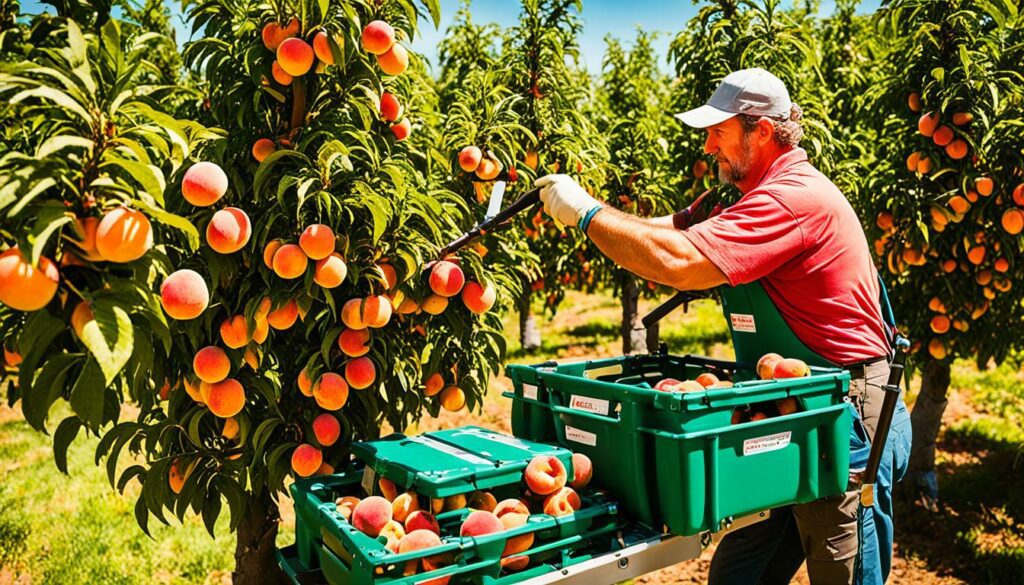
The changes they made really helped. The scores for how hard the work was on the body went down. The farmers felt better. They liked the new tools and methods that reduced the stress from their work. The farmers also helped decide what changes would work best, making sure they were practical and lasting.
Here, we’ll look at before-and-after details to see how things improved:
| Factor | Pre-Intervention | Post-Intervention |
|---|---|---|
| RULA Score | Action Level 3-4 (Immediate action needed) | Action Level 2-3 (Further investigation required) |
| Back Pain Incidence | 47.3% | Reduced significantly |
| Overall Farmer Satisfaction | Low due to physical strain | High due to ergonomic improvements |
This case study shows the real good from focusing on ergonomics in peach farming. It fits with the wider aims of ergonomic studies in farming too. By checking results and making practical changes, these efforts boost how well the farms work and the farmers’ health.
Ergonomic designs in farming help a lot. They cut down on injuries and make work easier. It’s clear these changes have many good points.
Research shows 30% of back injuries could be stopped with better ergonomics. Deere and Company’s story stands out. They cut back injuries by 83% with an ergonomics programme. Evidence-based ergonomics proves its worth.
Good ergonomic design boosts safety and productivity. A plant saved a lot of money this way. They also saw a big rise in how much they got done.
A medical call centre saw less complaints after making ergonomic changes. This shows how important these small changes can be for everyone’s happiness at work.
In farming, key lessons have shown ergonomic changes can greatly improve work and cut down on injuries. These success stories prove that a well-designed approach can create real and lasting improvement in ergonomics.

Research looked at 92 studies, split into different types of interventions. They used various methods, like time series and cross-sectional studies. A strict rule cut out studies with too few participants for accurate results.
Changes to how work is done often had mixed results because of poor analysis. But, making changes to the work itself, and when the workers were closely involved, showed good signs. This included things like physiotherapy, learning about health, relaxing techniques, and adjusting how the job was done. Changes to how the organisation is run also made a big difference.
| Intervention Type | Studies Included | Outcome Notes |
|---|---|---|
| Mechanical Exposure | 20 | Outcomes uncertain; inadequate statistical analyses |
| Production System | 32 | Successful when ownership embedded within the company |
| Modifier | 39 | Positive results with worker involvement |
As many as 60% of workers in offices develop musculoskeletal issues in their upper limbs and neck. Changing how workstations are set up, like using special mouse supports, helped lower these issues. Adding more breaks also made jobs like data entry more comfortable. But training didn’t always show a clear benefit in avoiding these issues.
Studies show we need more research to really understand how to make workspaces better. Even so, early successes make a strong case for using ergonomic methods to make working more efficient and less physically demanding.
Using the right ergonomic strategies is key in farming. It makes the work easier and deals with muscle and joint problems farmers often face. In Korea, a big 2020 study showed that 84.6% of farmworkers have health issues because of their work. Back pain is the main issue, affecting 47.3% of them. This shows how important it is to design special ergonomic solutions for farming areas.
Some tools, like special bucket carriers and farm gloves, can cut down on the hard physical work. This not only makes things easier but also boosts how much you can get done. Deere and Company proved this through training schemes. They cut back injuries by 83% and also spent 32% less on health costs.
A Die Cast Plant also benefits a lot from using ergonomic methods. They saw a 54% jump in work output and saved $1,910,000 a year because of it. These stories show that making work kinder on the body can help a business in big ways.
Special equipment, like ergonomic baskets and lift helps for heavy stuff, is a key part of this change. It makes the team healthier and the job smoother.
| Company | Intervention | Result |
|---|---|---|
| Die Cast Plant | Ergonomic Solutions | Productivity increased by 54% |
| Deere and Company | Ergonomic Training Programs | 83% reduction in back injuries |
| Korean Farmers | Handling Ergonomic Tools | Significant decrease in MSDs |
| US Department of Labor (2016 Study) | Improved Workplace Design | 30% of back injuries avoided |
Back pains are a big issue in the farming world, so we need to focus on special ergonomic methods. By choosing methods that have proof, like in the cases above, we can cut down on injuries. The US Department of Labor says nearly a third of back surgeries could be stopped by making workplaces and tasks better.
By picking the right ergonomic solutions for different farming jobs, we can see serious changes. Work gets done better, and farmers stay healthier. This way, everyone wins and our farms can run at their best.
Looking at different cases, we can see how making things ergonomic in farming really helps. It makes work safer and increases how much gets done by a lot. In the US, they found that up to 30% of back injuries might not need surgery if work areas are designed right.
Other jobs have seen big benefits too. In a die cast plant, spending $495,500 on making things better led to saving $1.91 million every year for ten years. Workers there needed less time off, and they made more things better without getting hurt. This shows big improvements can happen in different places.
For example, Deere and Company saw 83% fewer back injuries after focusing on ergonomics for ten years. This meant less money spent on healthcare too. Across different jobs, people had fewer muscle problems when their workplace was made to fit them better. In Washington, they saw big drops in how much they had to pay out for injuries and in work missed.
The improvements in farming due to ergonomics show a really good long-lasting effect. Making work areas fit for people reduces injuries and makes things get done better. It’s important for everyone in farming to push for better ergonomic solutions. This not only makes people healthier but also helps businesses do better.
Back pain, knee, and shoulder issues are common in farmers. These come from heavy lifting and using hands a lot. Also, working in very cold or hot weather for long times causes them.
Many farmers get musculoskeletal disorders because of hard work and getting older. Ergonomic improvements aim to cut down on these injuries and make farms more efficient.
In the participatory approach, farmers and experts work together on ergonomic fixes. This teamwork ensures practical and easy-to-use solutions for the farm.
Ergonomic bags are helping in coffee picking, and special tools are improving orange picking in mountains. These changes have made work easier and boosted productivity.
There are new tools like ergo bucket carriers and special hand gloves for farming tasks. They are made to lessen the stress on the body and make work safer and more effective.
By designing tools that are easier to use, harvesting becomes less tiring. For example, ergonomic coffee bags and orange picking tools, make the job easier and more efficient.
The latest studies show that improved tool design, better organizing work, and training can make farms safer and more efficient. These steps are aimed at reducing injuries and promoting better farm work habits.
Many ergonomic solutions are affordable for farmers. They include changing tools or the way work is done to keep workers healthy and productive without spending too much.
In a study focused on peach farming in Korea, an ergonomic plan was put in place. This plan significantly reduced the strain on farmers’ bodies. The key was getting everyone involved.
Ergonomic tools and workstations lower the risk of injuries and make work easier. This leads to a healthier and happier work environment, improving the overall farm life.
Successful ergonomic changes bring less strain, safer work, higher production, and happier workers. These benefits have been seen in many farming situations.
By tailoring proven strategies to each farming sector, ergonomic practices can spread. This sharing of best practices helps make farms safer and more efficient.
Ergonomic improvements reduce injuries, help workers stand and move better, and simplify tasks. This creates a work environment that is both healthier and more productive, especially in farming.